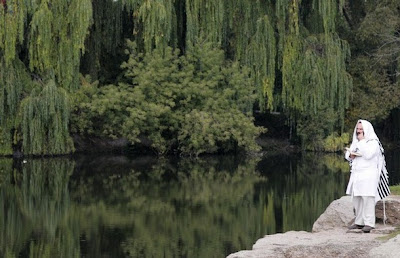Question & Answer With Rabbi Tanchum Burton - Advice & Initiative
A Simple Jew asks:
In Rabbi Chaim Kramer's book, "Through Fire and Water" he wrote, "It is up to the individual to take the initiative and act on the Rebbe's advice. The Rebbe's lessons are universal, speaking to each individual on his own level in accordance with his unique mission in life."
Additionally, he observed, "What is striking about his teachings is that, while the tzaddik is undoubtedly the central figure, he rarely intervenes as such in the lives of his followers. Rather, he observes and - most important - advises, sometimes with as little as a nod, a gesture, or even silence."
Is this "hands off" approach to leadership unique to Breslov or are you aware of any other Chassidic groups which are predominantly guided by the self-motivation of the chassidim?
Rabbi Tanchum Burton answers:
It seems to me that Rabbi Kramer was utilizing a rather poetic device to describe the experience one has when learning the works of Rebbe Nachman.
In Likutei Halachos, Shluchin 5, Reb Noson indicates that we do not need the Tzaddik for his arms and legs, but rather for his teachings. What he seems to have indicated is that the whole experiential aspect of having a rebbe - the grandeur of the court, the slices of fruit passed from hand to hand at the rebbe's tisch, the rebbe's royal appearance - is not as important as the avodas Hashem that results from the successful learning and integration of that rebbe's teachings. The litmus test of a rebbe-chassid relationship is whether or not the quality of the chassid's faith and service of G-d through Torah and mitzvos has increased by virtue of his encounter with the rebbe.
The Rebbe said that he wanted us to be gebakeneh chassidim, literally, "baked through and through". What he meant was that our integration of his teachings should be so thorough that every aspect of our avodas Hashem should reflect these teachings. That does not mean that we have to follow a particular chassidische dress code, or eat specific types of Jewish foods (although the Rebbe was clear that a Jewish appearance, e.g. a beard and payos, was important, see Chayei Moharan). What it does mean is that, given that his writings are replete with advice on how to serve G-d, we ought to turn to those writings, as they contain everything we need to live and grow as Jews. Thus, the teachings are the most important aspect of the Rebbe.
Breslov has a very unique tradition in this manner. Amongst the Breslover chassidim have been many people who could easily have become chassidic rebbes in their own right, having distinguished themselves as Torah scholars, dayyanim, miracle workers, and intense ovdei Hashem. Nevertheless, these people chose to remain talmidim of Rebbe Nachman. The Rebbe himself was very different from his contemporaries. Most of the time, when we read about the "chassidic masters", we find descriptions of spiritual superstars and their accomplishments, and of the size of their large followings - but rarely do we read about talmidim who have attained high levels. With Rebbe Nachman, although we have a litany of accounts that aptly convey a sense of his stature as a rebbe and tzaddik, the most important mesora we have from him is his advice on how WE can become spiritual superstars. It is this coaching role that the Rebbe plays in our lives that I feel distinguishes Breslov from other traditions.
The Rebbe physically left this world in 1810, but remains with us through the daas he bequeathed to us, and through the mesora that his talmidim in each generation have passed down to us. Since the Rebbe's teachings are the main vehicle by which one, through learning and integrating them, forges his relationship to him, it is up to the individual to take the initiative. That may explain what appears to be a "hands-off" approach in Breslov. But I can assure you that with the right teachers and good friends, when you get caught in the Rebbe's "net", the desire to live these eitzos make them no less than standing orders. May Hashem help us merit this.










1 Comments:
This, too, is implied by the story of the Jew who dreamed that a treasure was buried near a bridge in a faraway city and after traveling there, he met the guard and heard about his dream: that a treasure was buried under the stove of a Jew with the same name as dreamer #1. The Rebbe explains the moral of this story to be that the spiritual treasure we desire is within ourselves, but we must seek out a tzaddik to find it.
This is a good indicator of how Reb Nachman understood his role as a Chassidic rebbe: as a facilitator for those who came to him to realize their potential and reach their ultimate goal.
Thanks, Reb Tanchum, for another inspiring post!
Post a Comment
<< Home